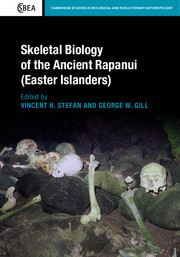Book contents
- Frontmatter
- Contents
- List of contributors
- Acknowledgements
- 1 Introduction: Research overview
- 2 Review of Polynesian and Pacific skeletal biology
- 3 Chronology and Easter Island prehistory
- 4 A descriptive skeletal biology analysis of the ancient Easter Island population
- 5 Craniometric variation of the prehistoric Polynesians and Rapanui
- 6 Rapanui non-metric cranial traits
- 7 Intra-island discrete cranial trait variation
- 8 Continuous non-metric characteristics of the early Rapanui
- 9 Rapanui dental morphology
- 10 Pelvic variability and sexual dimorphism in prehistoric Rapanui
- 11 Genetic affinities of the Rapanui
- 12 Archaeogenetics and paleodemographic estimation of founding populations: Features of residential geography on Rapa Nui
- 13 Evidence for injuries and violent death
- 14 Demographic analysis of modified crania from Rapa Nui
- 15 East Polynesian and Paleoindian parallels and contrasts in skeletal morphology
- 16 Rapanui origins, relationships, and warfare: A summary in theoretical context
- References
- Index
8 - Continuous non-metric characteristics of the early Rapanui
Published online by Cambridge University Press: 05 December 2015
- Frontmatter
- Contents
- List of contributors
- Acknowledgements
- 1 Introduction: Research overview
- 2 Review of Polynesian and Pacific skeletal biology
- 3 Chronology and Easter Island prehistory
- 4 A descriptive skeletal biology analysis of the ancient Easter Island population
- 5 Craniometric variation of the prehistoric Polynesians and Rapanui
- 6 Rapanui non-metric cranial traits
- 7 Intra-island discrete cranial trait variation
- 8 Continuous non-metric characteristics of the early Rapanui
- 9 Rapanui dental morphology
- 10 Pelvic variability and sexual dimorphism in prehistoric Rapanui
- 11 Genetic affinities of the Rapanui
- 12 Archaeogenetics and paleodemographic estimation of founding populations: Features of residential geography on Rapa Nui
- 13 Evidence for injuries and violent death
- 14 Demographic analysis of modified crania from Rapa Nui
- 15 East Polynesian and Paleoindian parallels and contrasts in skeletal morphology
- 16 Rapanui origins, relationships, and warfare: A summary in theoretical context
- References
- Index
Summary
Introduction
The non-metric characteristics of the human skeleton that follow a morphological continuum of expression, that is, traits like length of the nasal spine, supraorbital ridge size, and degree of development of the nasal sill, are traits known by human osteologists to pattern quite differently by population and by sex. For instance, males tend to have large or medium supraorbital ridges and females generally show very slight ridges or none at all (Bass, 2005; Byers, 2011; White et al., 2012). Europeans and White Americans have sharp nasal sills and prominent nasal spines while American Blacks have very dull or absent nasal sills and very reduced nasal spines (Bass, 2005; Byers, 2011; Gill, 1998; Rhine, 1990; White et al., 2012). These traits, in fact, are so valuable in the human identification process that many, if not most, forensic anthropologists rely upon them more than craniometrics or discrete non-metric traits in analysis of skeletons. Unfortunately, in scientific research, working with these kinds of morphological characteristics is difficult. This is because they are hard to quantify. The precise numerical data of osteometrics, and repeatability between scientists in their application, facilitate effective quantitative analysis. The occurrences of discrete non-metric traits can likewise be expressed in frequencies with reasonable precision. The continuous, non-metric traits, on the other hand, provide no clear classificatory boundaries, and therefore must be assessed more subjectively. This, in turn, leads to greater inter-observer error. So, these very important traits, with very high heritability, and therefore great utility in defining populations and individuals, are not easy to work with, and therefore are often ignored in systematic population studies.
On the other hand, the value of these particular non-metric traits in assessing both sex and ancestry has been well known in physical anthropology since the earliest days of this field of science. E.A. Hooton at Harvard in the early part of the twentieth century defined many of the non-metric traits still utilized today in forensic anthropology and other areas of biological anthropology. For a comprehensive view of Hooton's list of these traits one may consult Brues (1990).
Very few non-metric discrete traits of the cranium will be discussed in this chapter since they are covered thoroughly in other chapters of this book (Chapman, Chapter 6; Furgeson and Gill, Chapter 7).
- Type
- Chapter
- Information
- Skeletal Biology of the Ancient Rapanui (Easter Islanders) , pp. 131 - 154Publisher: Cambridge University PressPrint publication year: 2016



